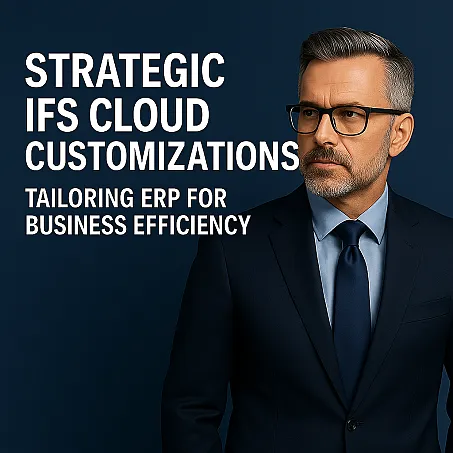Executive Summary
Strategic application of IFS Cloud customizations can significantly enhance operational efficiency, user adoption, and data-driven decision-making. When executed within a structured DMAIC framework and aligned with MECE principles, customizations yield measurable business value while maintaining system integrity.
Key takeaways:
-
High ROI potential in targeted areas: UI personalization, workflow automation, and enriched data models.
-
Critical success factors include stakeholder alignment, rigorous testing, and staged deployment.
-
Risks - such as scope creep, performance degradation, or compliance issues - must be mitigated via robust governance and continuous improvement cycles.
DMAIC Breakdown (MECE-Structured)
1. Define – Problem Statement & Objectives
Problem: Standard IFS Cloud functionality may not fully reflect unique business processes, leading to inefficiencies, manual workarounds, and suboptimal reporting.
Objectives:
-
Enhance user productivity through UI customization (dashboards, branding).
-
Improve operational efficiency via custom workflows & automation.
-
Strengthen reporting & compliance with extended data models.
Scope:
-
Focus on three distinct customization areas (UI, Business Logic, Data Model).
-
Limit changes to those delivering measurable business process improvements.
2. Measure – Baseline Metrics & KPIs
Key Metrics (Pre-Customization Baseline):
-
User task completion time (min/transaction).
-
Error rates in manual processes (%).
-
Data completeness & accuracy (%).
-
User adoption rates (% active usage vs. total licensed).
-
Report generation time (min).
Measurement Plan:
-
Use system logs to establish baseline performance.
-
Capture qualitative feedback from key user groups.
-
Benchmark against similar ERP deployments in industry.
3. Analyze – Gaps & Root Causes
UI Customizations – Gaps
-
Standard dashboards lack role-specific KPIs → delays in decision-making.
-
Generic theming reduces user engagement & familiarity.
Business Logic – Gaps
-
Manual workflows in procurement & approvals create bottlenecks.
-
Repetitive data entry leads to errors & low morale.
Data Model – Gaps
-
Missing fields for compliance-specific reporting.
-
Weak entity relationships hinder cross-department analytics.
Root Causes:
-
One-size-fits-all ERP configuration.
-
Insufficient alignment between ERP standard processes & actual business workflows.
-
Limited awareness of IFS customization capabilities.
4. Improve – Solutions & Recommendations
UI Enhancements
-
Deploy custom role-based dashboards (Ops, Finance, SCM).
-
Apply corporate branding for familiarity and faster adoption.
Business Logic Enhancements
-
Automate recurring approval flows in procurement and expense management.
-
Implement error-checking scripts to reduce data entry mistakes.
Data Model Enhancements
-
Add custom compliance fields to supplier master data.
-
Define new relationships between customer orders and service contracts for better lifecycle analysis.
Quick Wins (≤3 months)
-
Custom dashboards.
-
Simple workflow automations.
-
Low-complexity field additions.
Long-Term Initiatives (>6 months)
-
Complex data model restructuring.
-
Enterprise-wide automation strategy.
5. Control – Governance & Sustainability
Governance Mechanisms:
-
Establish a Customization Steering Committee for change approvals.
-
Maintain a Customization Registry documenting scope, owner, and dependencies.
Testing & Deployment:
-
Apply User Acceptance Testing (UAT) in a sandbox environment.
-
Use staged deployment to control risk.
Continuous Improvement:
-
Quarterly reviews of customization ROI.
-
User feedback loops via surveys and focus groups.
-
Align customization roadmap with IFS Cloud release cycles to ensure compatibility.
| Risk | Impact | Mitigation Strategy |
|---|---|---|
| Scope creep | Budget/time overrun | Use strict change control |
| Performance degradation | Reduced system speed | Test load impact before deployment |
| Compliance breaches | Regulatory fines | Involve compliance in requirements |
| User resistance | Low adoption | Early stakeholder involvement + training |
